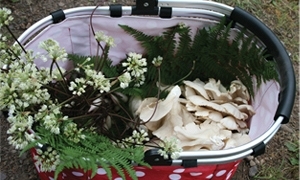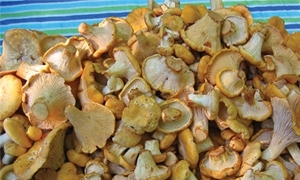In a thick-bottomed saucepan, melt 1 tablespoon of butter. Saute the two garlic cloves and the onion in it until they become soft, but not brown. Incorporate the mushrooms and the spices until the mushrooms release their water, which takes a few minutes. (As a variation of this recipe, add the mushrooms at the end of the process if you want them to be a little bit crisp.) Add flour and stir for one minute without allowing it to turn brown. Using a whisk, gradually incorporate the milk, broth and wine until all the lumps are gone. Continue stirring until the sauce thickens. Do not let it boil. Meanwhile cook the pasta al dente. Drain and add it to the sauce along with the chicken, parsley and Parmesan. Pour into a casserole.
Garnish: in a small frying pan melt the butter at low heat. Brown the garlic. Add the breadcrumbs, parsley and Parmesan. Mix well. Spread over the casserole.
Cook in the oven at 375 for 30 minutes until the sauce starts bubbling and the breadcrumbs turn golden brown.
Quiche of Morels, Caramelized Shallots, Asparagus, Goat Cheese and Chives
(serves 4-8)
1 cup morel mushrooms (Chanterelles and oyster mushrooms work well, too)
10 shallots, medium, sliced (Substitution: A nice seasonal treat in the early spring in Wisconsin are Ramps, also known as wild leeks. You will want to cook them a little bit longer while sautéing the morels to reduce the garlicky bite of this marvelous wild edible.)
1 1/2 oz olive oil
1 bunch asparagus, trimmed, cut into 1 1/2-inch lengths at a bias (angle), blanched in salted boiling water and shocked immediately in ice water and drained to preserve color.
½ oz dry vermouth
8 eggs
1 cup half & half
4 oz goat cheese, soft plain Montrachet-style fresh cheese
Salt and pepper to taste
1 bunch chives, chopped to 1/4-inch lengths
1 12-inch pie pan lined with crust, par-baked (see recipe below)
Note: Morels are, as with most edible mushrooms, partially indigestible when raw, so it is essential to thoroughly cook the mushrooms in any dish.
Preheat the oven to 450. In a 12-inch skillet, heat half the oil over medium heat and add the sliced shallots. Allow the shallots to sweat down a little bit and brown on the bottom before flipping them. Adding a tiny bit of salt can help caramelize them as it draws out the juices onto the hot pan. When the shallots are soft and the edges show some color, remove them from the pan and add the rest of the oil to the pan. Add the morels and asparagus, and toss them in the oil so that they are coated. Raise the heat and cover, allowing the asparagus and morels to cook and soften for 4-5 minutes. Remove the cover and allow the liquid to reduce to almost nothing (au sec). Remove the pan from the heat and sprinkle the contents with the chopped chives and salt and pepper to taste. Sprinkle with the Vermouth or another dry white wine. If you have no Vermouth or prefer not to use wine, sprinkle with the juice of half a lemon. Acid helps to bring out the flavors on the palate and helps balance the fats on the tongue. Allow to cool for 5 minutes.
Meanwhile, combine the eggs with the half and half and a pinch of salt and pepper. (Note: If using a whisk, try not to incorporate too much air into the mixture or your final savory custard will soufflé in the oven and the end product will be texturally less smooth than desired.)
Line the pie crust with the mushroom mixture leaving as much of the pan juice in the pan as possible. With your fingers break off small knobs of the goat cheese and incorporate them with the mushrooms. Pour the egg mixture into the pie shell, just covering the cheese and mushrooms. Some of the chives will float up, but don’t worry, it’s all part of the process.
Baking: Place the uncooked quiche into the 450 degree oven for 10 minutes to brown the pastry then reduce the temperature to 350. Keep a close eye on the quiche. Depending on the construction of the pan, your oven and the temperature of the ingredients when they went in the pan, the time it will take for the custard to set could vary quite a bit. Also note that if the pan is still hot from blind baking the crust, the custard may set more quickly. When checking the quiche for doneness, very gently bump the pan to see how much jiggle you have. The center of the pan will always be the last part of the quiche to set. Once the center is just barely set, (jiggly but certainly not sloshy) you can remove the pan from the oven to the counter to cool. The cooking process will carry over for several minutes after the quiche is removed from the pan from the residual heat/thermal mass. Overcooking the egg mixture by leaving the quiche in the oven until entirely firm will cause the delicate matrix of egg protein strands to contract, squeezing the liquids out of the matrix, the end result being a watery yet mealy dry texture to the custard.
Allow to cool for 10-15 minutes before serving. Quiche can also be precooked, cooled and stored for later consumption or even frozen and brought out for that special occasion. Just reheat in a low oven until warmed through.
Mushroom Bolognese
serves 8-12
This is the perfect meat sauce for just about any Italian dish and portions can be frozen for later use. You can also halve the amount you’re making, but why?
4 oz diced pancetta (or good bacon or salt pork)
1 cup olive oil
1 lb onions diced
8 oz celery diced
salt and pepper to taste
4 lb ground beef (or mixture of ground beef, venison, and/or pork — I prefer ground lamb)
3 cups white wine
3 cups whole milk
pinch fresh nutmeg
3 lbs wild mushrooms chopped (just about any summer mushrooms work, I especially like Oysters)
5 lbs canned plum tomatoes, drained
Preparation
In a large skillet, render pancetta over low to medium heat for 6-8 min and remove from pan. Add half cup olive oil, onion, and celery. Cook over medium to medium-high heat for 12 minutes or until onions are just translucent. Add salt and pepper to taste. Add ground meat mixture, breaking apart as it cooks, mashing if necessary to obtain a fine texture. Cook 6-8 minutes, until meat is no longer pink, but do not brown. Move meat to one side and remove as much fat as possible. Add wine and reduce heat to a bare simmer and cook until almost dry, about 15 minutes. When wine has evaporated, add whole milk and nutmeg, simmer lightly until almost dry. Remove pan from heat. Heat another large skillet with remaining half cup of olive oil, add mushrooms, and cook until all moisture is driven off and they turn golden brown. Season with salt and pepper. Note: you may have to cook mushrooms in batches. Drain tomatoes, reserving juice (use juice to thin sauce later, if desired), and crush tomatoes by hand. Add tomatoes and mushrooms to the meat sauce and cook slowly until meat is soft and sauce has thickened slightly. Serve over any pasta or use the meat sauce for baked pastas.
Recipes 1 and 2 from FUNGI magazine (www.fungimag.com) and recipe 3 from (with permission) Edible Wild Mushrooms of Illinois and Surrounding States: A Field-to-Kitchen Guide by J McFarland and G M Mueller, University of Illinois Press, ISBN 978-0-252-07643-5 and is by far the best beginner’s field guide to mushrooms of the Wisconsin region.
|















